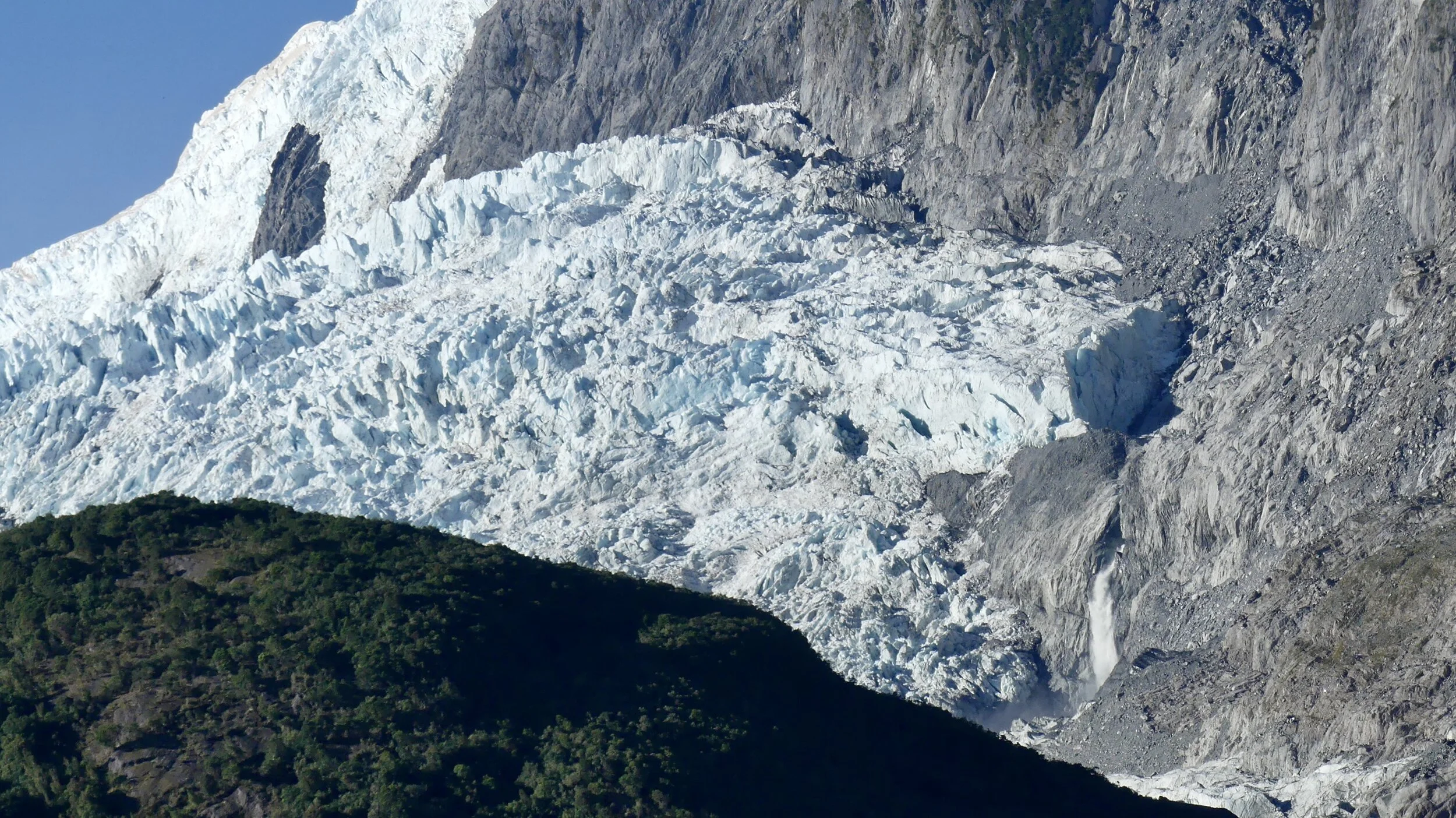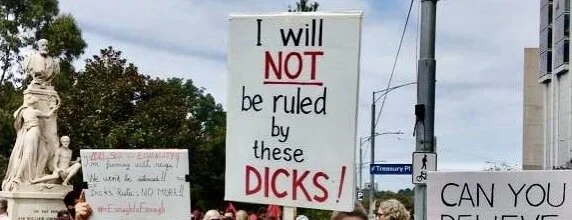West Coast: glaciers, faults & pancakes
Haast Visitor Centre had the up-to-date lowdown on South Island’s famous glaciers. Fox was out of the question following heavy rains, flooding and a huge landslip in the valley that had taken out the access road. It was possible to walk to a viewpoint a kilometre from Franz Josef. This was beyond disappointing, but I hadn’t come all this way not to see a glacier at all.
Haast Highway hugs the coast, which is striking although not always beautiful, with interesting vegetation.
Despite initial disappointment, the anticipation and awe on first sight of Franz Josef Glacier was considerable. A Panasonic Lumix zoom helped bring the ice drama closer.
Mountains from our hotel in Franz Josef town
Pink snowfields courtesy of Aus bushfires
The glacier is retreating fast: the ice was 2 km from the lookout the day we were there, twice as far as we’d been told in Haast. The only way of getting close is to go on a guided walk or a heli-hike. There wasn’t time for the first, but no way we’d have done the second. Helicopter noise had woken us early that morning; and flying to and landing on the ice is about as unsustainable as tourism gets.
As I chatted to a lady from Maine at the lookout, I dared hope that concern about climate inaction might be growing across the planet. More than a year on, however, the Australian government’s intransigence is same as it ever was, or worse.
New Zealand Giant Dragonfly
Fantail
Haast Visitor Centre had also told us about the Alpine Fault Tour from Whataroa, which was a must for my friend. It was almost bound to be more satisfying than our San Andreas Fault experience a few years ago. After a 30-km drive from Franz Josef to Whataroa, and a geology briefing, we set off in a 4WD bus for Gaunt Creek. Progress was slow and bumpy: we had little idea exactly where we were going, or for how long.
What we had come to see was an extrusion of ‘fault gouge’, a small-grained, relatively soft rock formed by tectonic forces, in this case the Pacific plate and the Australian plate sliding past each other in opposite directions. The mint green material in the pictures below is the gouge.
It’s hard to visualise a fault 130 metres below one’s feet. I’ve only ever imagined a fault as a discontinuity – an interruption in rock strata on either side of a fracture as one rock mass moves up or down relative to the other. Guides who lead eager tourists in unfamiliar territory have to create excitement, whether it be ‘slot canyon’ diversions vaguely near the San Andreas Fault, or holes to insert your finger into ‘near’ the South Alpine Fault!
Evidence of the nearby fault?
Gaunt Creek
The tour took longer than expected: it was slow-going over the boulder-strewn Creek bed. Whataroa to Hokitika was more than 100 km: straight stretches and keepy-uppy with local drivers meant we arrived at the lovely Stations Inn – complete with alpacas and sundown over the Tasman – with 25 minutes to spare before supper at 7.
I liked Hokitika, although the beach, by any antipodean standard, was a mess. I hadn’t up until now paid much attention to New Zealand’s highest mountain (Aoraki/Mount Cook) because we weren’t going anywhere near it; but someone mentioned that on a fine day you can see it clearly from Hokitika. From then on I peered between clouds for tall peaks.
Above and below: Hokitika River
New Zealand Flax in the foreground
We wandered round this cool little town, as ever on the lookout for pounamu (greenstone or nephrite jade). My friend was searching for rough, unpolished rocks – which we knew by now he was unlikely to find – while I was after unusual jewellery, more specifically, a bracelet. I already had my simple pendant from Arrowtown, but a bracelet was proving more of a challenge. I found it in the shop above, in the form of raukaraka pounamu, which has striking yellow and dark tones through the greens. Pounamu occurs in a range of colours with many variations: no two pieces are alike.
We made a beeline for the town’s bookshop: I wanted to read some recent New Zealand fiction. The bookseller went straight for The Luminaries by Eleanor Catton, Booker prizewinner in 2013 and one of the best books I’ve read in a long time. It tells of those who came to make their fortune in South Island’s goldfields in the 1860s. There are many characters and a complex plot in the book’s 800 pages, but Catton is such a good writer you rarely have to refer back to recall who someone is or where they fit into the web of intrigue.
Hokitika grew rapidly as diggers arrived and built themselves shelters and camps. It was soon amongst New Zealand’s most important ports: shipwrecks were common. It’s one of the wettest places in the country. There’s a lot of rain in the book.
Next day we headed further north, beyond Greymouth, West Coast’s largest town. Dolomite Point, just south of the small community of Punakaiki, is where you’ll find Pancake Rocks, the highlight of a stunningly eroded stretch of coastline.
Weird and wonderful creatures
Stylobedding process
The formation of limestone landscapes is well understood, but these pancakes long puzzled geologists. Most now believe a secondary process, stylobedding, was at work here. As shell and skeletal fragments were buried and compacted, some were under such great pressure they became a solution, in which minerals mixed in places and formed thin mudstone layers within the limestone. Millennia later, the rock was above sea level; mudstone eroded faster than limestone; and eventually piles of pancakes were created.
Then there were Nikau Palms, the only native palms on mainland NZ and the southernmost naturally growing palm on the planet. They can reach 10 metres in height, and their fronds – which seemed upside down to me – are produced from a single ‘bud’ at the tip of the trunk.
Punakaiki is right beside Paparoa National Park. The Visitor Centre suggested a walk along the Pororari River track as far as the lookout: it was lovely.
Our South Island appreciation tour was almost over. The next day we left Hokitika for Christchurch, over the Southern Alps through Arthur’s Pass, at more than 3000 feet (900+ meters).
Heading for the hills
Above and below: engineering feats
Above and below: on the other side of the divide
There was a memorable moment in Arthur’s Pass. We’d seen keas in Queenstown but had longed to see them in the wild. Several people had mentioned the birds hanging out at Death Corner near the top of the Pass. We parked and walked away from people, scanning our surroundings. We were on the point of giving up when I spotted a bird circling. It landed on a pylon and sussed the scene below. Keas are intelligent, curious, mischievous and sometimes cruel. Unsurprisingly, numbers are declining; another exceptional creature at risk in a changing world.



